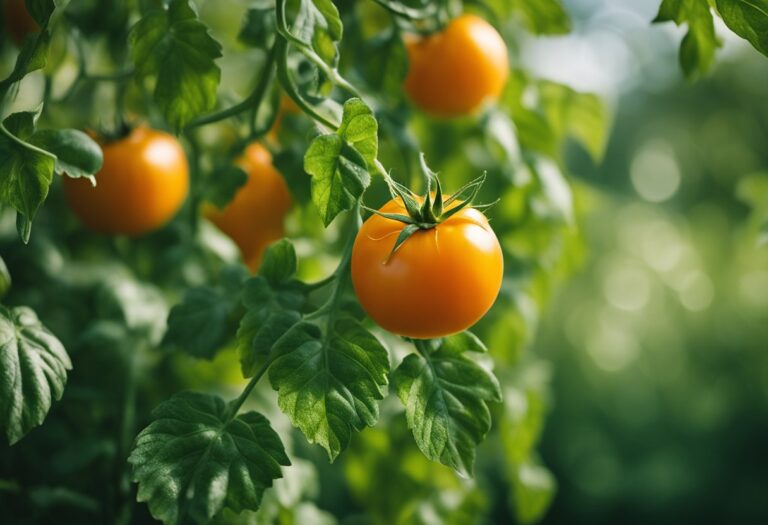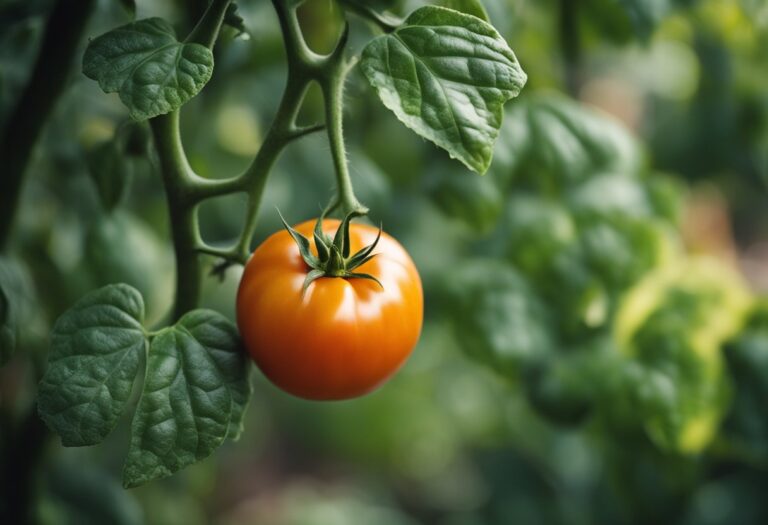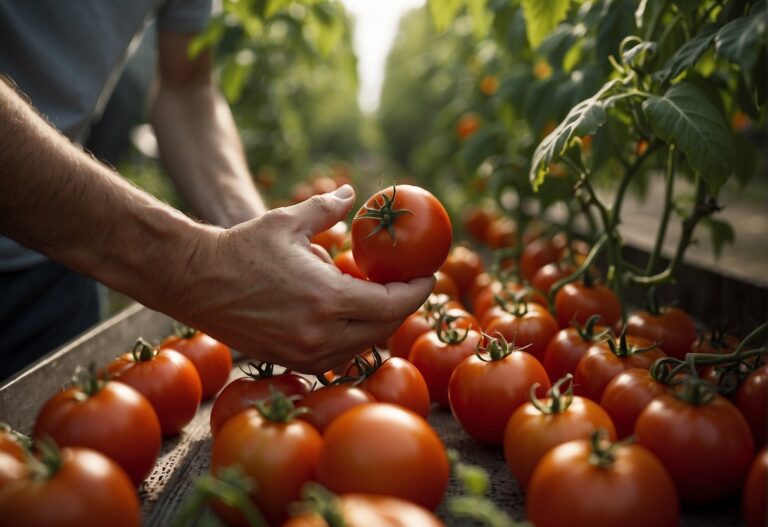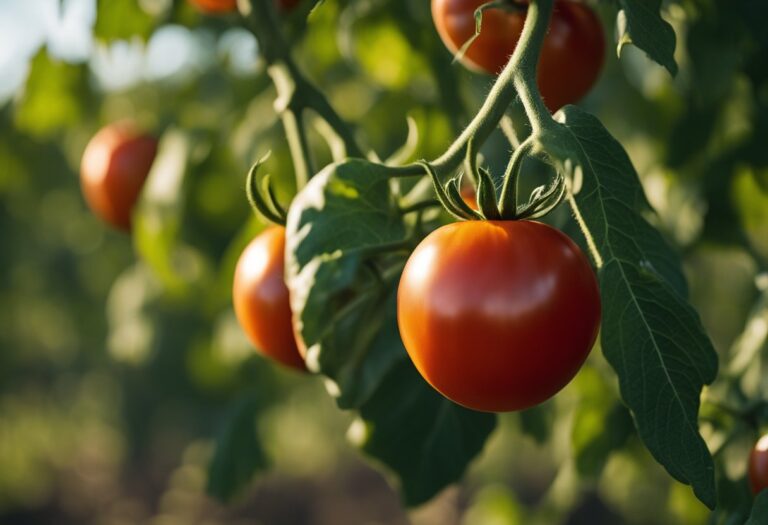How Often to Water Tomatoes: Tips for a Thriving Crop
If you’re growing tomatoes, one of the most important things to keep in mind is how often to water them. Watering your tomato plants correctly can mean the difference between a bountiful harvest and a disappointing one. In this article, we’ll cover everything you need to know about watering tomatoes, from understanding the basics to best practices for irrigation systems.

First, it’s important to understand the basics of tomato watering. Tomatoes need consistent moisture to grow and thrive, but overwatering can be just as damaging as underwatering. When the soil is too wet, it can lead to root rot and other fungal diseases. On the other hand, if the soil is too dry, the plants won’t be able to absorb the nutrients they need to grow.
So how often should you water your tomatoes? The answer depends on a variety of factors, including the size of your plants, the type of soil you’re using, and the weather conditions in your area. In the next section, we’ll dive into more detail on how to determine the right watering schedule for your tomatoes.
Key Takeaways
- Understanding the basics of tomato watering is crucial for a successful harvest.
- Overwatering and underwatering can both be harmful to your plants.
- The right watering schedule depends on several factors, including plant size, soil type, and weather conditions.
Understanding Tomato Watering Basics

The Role of Water in Tomato Growth
Tomatoes are mostly water, and they require plenty of it to grow properly. Water is essential for the plant to transport nutrients and minerals from the soil to the rest of the plant. It also helps to regulate the temperature of the plant, keeping it cool during hot weather. Without enough water, the plant will become stressed, and its growth will slow down or stop altogether.
When it comes to watering tomatoes, it’s important to strike a balance. Too much water can be just as harmful as too little. Overwatering can lead to root rot, which can kill the plant. It can also cause the fruit to split or crack, making it unattractive and less flavorful.
Signs of Overwatering and Underwatering
To determine whether your tomatoes are getting enough water, there are a few signs to watch out for. If the leaves are wilting or turning yellow, this could be a sign of both overwatering or underwatering. However, if the soil is wet and the leaves are yellow, it’s likely that you are overwatering. On the other hand, if the soil is dry and the leaves are yellow, you may be underwatering.
Another sign of overwatering is if the fruit is splitting or cracking. This is because the excess water causes the fruit to expand too quickly, which can cause it to burst. Underwatering can cause the fruit to become stunted or misshapen, and it may not ripen properly.
To avoid overwatering or underwatering your tomatoes, it’s important to water them deeply but infrequently. This means giving them enough water to soak the soil to a depth of at least 6 inches, but not so much that the soil becomes waterlogged. You should also avoid getting the leaves wet when watering, as this can lead to fungal diseases.
By following these simple tips, you can ensure that your tomatoes get the right amount of water they need to grow healthy and strong.
How Often to Water Tomatoes

Tomatoes are thirsty plants and require regular watering to grow healthy fruits. However, overwatering can lead to root rot, while underwatering can cause the fruits to crack. In this section, you will learn how often to water tomatoes based on their growth stages and the factors influencing their water needs.
Watering Frequency for Different Growth Stages
Tomatoes have different water requirements at different growth stages. Here’s a table to guide you on how often to water tomatoes based on their growth stages:
| Growth Stage | Watering Frequency |
|---|---|
| Seedlings | Every 2-3 days |
| Vegetative | Every 3-5 days |
| Flowering | Every 4-7 days |
| Fruiting | Every 5-7 days |
Note that these are general guidelines and your watering frequency may vary depending on your climate, soil type, and other factors. Always check the soil moisture level before watering your tomatoes.
Factors Influencing Water Needs
Several factors can influence the water needs of your tomato plants. Here are the most important ones:
- Temperature: Tomatoes need more water in hot weather than in cool weather. When the temperature is above 85°F, you may need to water your tomatoes twice a day to prevent the soil from drying out.
- Humidity: High humidity can reduce the water loss from the leaves of your tomato plants, while low humidity can increase it. If you live in a dry climate, you may need to water your tomatoes more frequently.
- Soil type: Sandy soils drain faster than clay soils, so you may need to water your tomatoes more often if you have sandy soil. Clay soils hold more water, so you may need to water your tomatoes less often if you have clay soil.
- Plant size: Larger plants need more water than smaller plants. If you have indeterminate tomato plants that can grow up to 6 feet tall, you may need to water them more often than determinate tomato plants that grow up to 3 feet tall.
By considering these factors and following the watering frequency guidelines for different growth stages, you can ensure that your tomato plants receive the right amount of water to grow healthy and tasty fruits.
Best Practices for Watering Tomatoes
When it comes to watering tomatoes, there are a few best practices to keep in mind to ensure your plants stay healthy and produce a bountiful harvest. In this section, we’ll cover three key areas: morning vs. evening watering, deep watering techniques, and mulching to retain moisture.
Morning vs. Evening Watering
The timing of your watering can have a big impact on the health of your tomato plants. It’s generally recommended to water your plants in the morning, as this gives them the opportunity to dry off during the day. Wet foliage can lead to the growth of fungal diseases, so it’s best to avoid watering your plants in the evening when the leaves won’t have a chance to dry before nightfall.
Deep Watering Techniques
When you water your tomato plants, it’s important to get the water down to the roots where it’s needed most. Rather than just sprinkling water on the surface of the soil, try using a soaker hose or drip irrigation system to deliver water directly to the root zone. This will encourage the roots to grow deeper, which will help your plants stay healthy and productive.
Another technique to try is deep watering. This involves watering your plants deeply but less frequently, rather than giving them a shallow watering every day. By doing this, you’ll encourage the roots to grow deeper in search of water, which will make your plants more drought-resistant in the long run.
Mulching to Retain Moisture
One final technique to consider is mulching. By adding a layer of organic material such as straw, leaves, or grass clippings to the surface of the soil around your tomato plants, you can help retain moisture in the soil. This will reduce the amount of water that evaporates from the soil surface, which means you’ll need to water your plants less frequently. Mulching also helps to suppress weeds, which can compete with your tomato plants for water and nutrients.
By following these best practices for watering tomatoes, you’ll be well on your way to growing healthy, productive plants that will provide you with a bountiful harvest. Remember to water your plants in the morning, use deep watering techniques, and consider mulching to retain moisture in the soil. With a little care and attention, you’ll be enjoying delicious, homegrown tomatoes in no time!
Irrigation Systems for Tomatoes
If you want to make sure your tomatoes get the right amount of water without having to manually water them every day, an irrigation system may be the solution. Here are two common irrigation systems that work well for tomatoes:
Drip Irrigation Benefits
Drip irrigation is a great option for tomato plants because it delivers water directly to the roots, minimizing water waste and reducing the risk of disease. Drip irrigation systems are also customizable, so you can adjust the amount of water each plant receives based on its individual needs.
Another benefit of drip irrigation is that it can be set up on a timer, allowing you to automate the watering process. This means you won’t have to worry about forgetting to water your plants or adjusting the watering schedule when you go on vacation.
Setting Up a Soaker Hose
A soaker hose is another option for watering your tomato plants. Soaker hoses are made of porous material that allow water to seep out slowly and evenly along the length of the hose. This ensures that water is delivered directly to the roots of the plants, reducing water waste and minimizing the risk of disease.
To set up a soaker hose, simply lay the hose along the base of your tomato plants and connect it to a water source. Make sure the water pressure is low to avoid damaging the plants. You can also cover the hose with mulch to help retain moisture in the soil.
Overall, both drip irrigation and soaker hoses are effective options for watering your tomato plants. Choose the system that works best for your needs and enjoy healthy, thriving tomato plants all season long.
Monitoring and Adjusting Watering Schedules
Using Soil Moisture Meters
One of the easiest ways to monitor the moisture level of the soil is by using a soil moisture meter. These affordable devices can be purchased at most garden centers or online. Simply insert the probe into the soil near the plant’s roots and check the moisture level on the display. If the meter indicates that the soil is dry, it’s time to water your tomato plants.
Soil moisture meters are especially useful for gardeners who are new to growing tomatoes or those who have trouble determining when to water their plants. By using a moisture meter, you can take the guesswork out of watering and ensure that your plants are getting the right amount of water.
Adapting to Weather Changes
The amount of water your tomato plants need will vary depending on the weather conditions. During hot, dry weather, your plants may need more frequent watering to prevent the soil from drying out. Conversely, during periods of heavy rain, you may need to reduce the amount of water you give your plants.
To adapt to weather changes, it’s important to monitor the moisture level of the soil regularly and adjust your watering schedule accordingly. Keep in mind that overwatering can be just as damaging to your plants as underwatering, so it’s important to strike the right balance.
In addition to monitoring the moisture level of the soil, you can also observe your plants for signs of stress. If your tomato plants are wilting or their leaves are turning yellow, it may be a sign that they are not getting enough water. On the other hand, if the leaves are turning brown and crispy, it may be a sign that they are getting too much water.
By using soil moisture meters and adapting to weather changes, you can ensure that your tomato plants are getting the right amount of water and thrive throughout the growing season.
Frequently Asked Questions
When should I stop watering my tomato plants?
You should stop watering your tomato plants about two weeks before the first expected frost. This will give the plant time to dry out and harden off before the cold weather sets in.
What is the daily water requirement for a tomato plant?
The daily water requirement for a tomato plant varies depending on the size of the plant, the stage of growth, the temperature, humidity, and the type of soil. As a general rule, tomato plants need 1 to 2 inches of water per week. However, during hot, dry weather, they may need more frequent watering to prevent the soil from drying out.
How should I adjust watering for tomatoes in a raised bed?
In a raised bed, the soil tends to dry out more quickly than in the ground, so you may need to water your tomato plants more frequently. Check the soil moisture regularly and water the plants when the top inch of soil feels dry to the touch.
What’s the best watering schedule for tomatoes during hot weather?
During hot weather, you may need to water your tomato plants more frequently to prevent the soil from drying out. Water the plants deeply in the morning and give them a second watering in the late afternoon. Avoid getting leaves and stems wet when watering tomatoes.
Is it possible to overwater tomato plants, and how can I avoid it?
Yes, it is possible to overwater tomato plants, which can lead to root rot and other problems. To avoid overwatering, water the plants deeply once or twice a week, depending on the weather and soil conditions. Check the soil moisture regularly and water the plants only when the top inch of soil feels dry to the touch.
Should I water my tomato plants in the morning or evening?
It’s best to water your tomato plants in the morning, so they have time to dry off before the cooler evening temperatures set in. Watering in the evening can lead to fungal diseases, as the plants may not dry off completely before nightfall.




